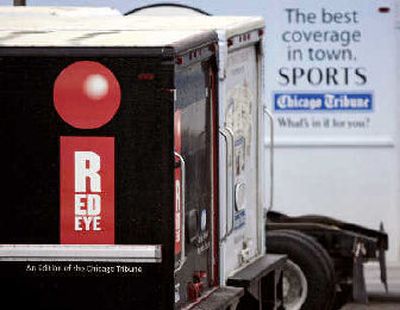Papers seek an edge

CHICAGO — Three years after it began, the battle of the Red tabloids is over.
It was a new-fashioned newspaper skirmish, in one of the few U.S. cities where two daily papers still compete head-to-head. In the end, the Chicago Tribune’s RedEye outlasted the Chicago Sun-Times’ Red Streak in the quest for young adult readers.
However, despite Red Streak’s Dec. 22 demise, the fledgling batch of U.S. newspapers aimed mostly at readers in their 20s and 30s is alive and growing. Similar publications targeting young urban professionals and commuters with short, edgy stories are starting to proliferate, and industry experts and media executives see some encouraging early results — mostly when the papers are free.
“Even if they fail to do what newspapers had originally intended, which is to develop newspaper reading habits, it looks as though some of these are starting to prosper in their own right,” said John Morton, an independent newspaper industry analyst in Silver Spring, Md. “So I don’t think you’ll see people start shutting them down unless they come under financial strain.”
Experts cite strong advertising potential and some steps toward success at many of the free tabloids, including Metro, published by London-based Metro International with separate editions in several U.S. and European cities; Express, owned by The Washington Post Co.; Tribune Co.-funded RedEye and amNewYork; and Quick, published by Belo Corp.’s The Dallas Morning News.
“Globally, the future is in this type of publication,” said Michael P. Smith, executive director of Northwestern University’s Media Management Center and Readership Institute. “The research we’ve seen lately indicates there’s still a lot of room in the market for more demographically targeted newspapers.”
Growth in any category is welcome in the struggling newspaper industry, as traditional dailies endure ongoing circulation declines and more consumers get their news and information online without paying for it. Newspapers’ very survival is at stake; according to a recent Carnegie Corp. study, the average age of U.S. newspaper readers is 53 and climbing.
Newspaper companies are trying a variety of experiments to combat the loss of paying readers, from new online strategies to free papers to “citizen journalism,” enlisting the public to help report and analyze news and information in their communities. Industry veteran John Kimball says there’s more risk-taking going on now than he’s seen in 35 years in the business.
“There are serious issues that the industry’s facing, but we’re certainly not burying our heads in the sand,” said Kimball, chief marketing officer of the Newspaper Association of America, a trade group. “There’s a great deal of experimentation going on — with youth, with free distribution, with different editorial content models. Stuff that works is hanging around, and stuff that doesn’t work isn’t.”
Red Streak isn’t hanging around because it didn’t make money. A copycat mission from the start, it was launched in 2002 the same day as long-planned RedEye and with the same focus on local entertainment, sports, fashion and celebrity gossip. But the company with more resources prevailed.
Analyst Morton said that while the end of Red Streak is “not a favorable sign,” the failure is a special case because of the financial woes of the Sun-Times’ parent, Hollinger International Inc., and its status as the city’s second newspaper.
The Sun-Times could at least declare one mission accomplished — preventing its rival from setting up a successful paid-circulation tabloid, after Tribune dropped the 25-cent cover charge for RedEye on Oct. 3.
Meanwhile, RedEye’s business is healthier than ever, according to its general manager, Brad Moore, although he declined to disclose financial details.
Like similar papers, RedEye’s daily circulation is far less than its mother publication’s — about 94,000 compared with over 586,000 for the Tribune as of September. But media watcher Smith pronounced it very successful at grabbing not only readers but new advertisers. More than half its 1,400 advertisers had not appeared in the Tribune.
Since going free in October to expedite growth, Moore said, “We’re distributing more copies, readership is up and advertisers are flocking.”
The young adult newspaper description is evolving more into “quick-read” papers as the genre evolves, he said, noting that a significant portion of RedEye’s readership is older than the coveted 18-to-34 demographic.
“It’s about packaging news and information in a format when and where people want it,” he said.